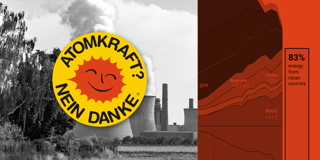What different degrees of global warming look like
Hi, it’s Gregor again, CTO of Datawrapper. Last Friday millions of people were protesting around the world, demanding more decisive actions on climate change from their governments. So I thought it’s a good time for another Weekly Chart on this topic…
Perhaps the most central aspect of our climate crisis is the fact that the greenhouse gases in the atmosphere are leading to a warming of our planet. The warming is already underway and it’s measured as global mean surface temperature. When you hear “we need to stay below 1.5 degrees of warming,” it’s this temperature that’s being referred to.
One big problem with this data is that when some people hear of 3°C warming they might think that that’s not too bad. On some cooler days in Berlin, many would even welcome a few extra degrees. But a global mean surface temperature increase of 3°C means an increase of the average of all temperatures, including summer and winter, Northern and Southern Hemispheres, land and ocean. Local effects of such warming are a lot more severe.1
Chart choices
This chart is all about the annotations! I wanted to have a lot of room for them, so I extended the y-axis to the top and picked a very tall aspect ratio. The colored bands in the background (created with our range annotation feature) visually divide the vertical scale into different “heat zones.” To be able to use colors that really pop out, I used white as text and line color.
The text annotations mention some of the effects that will become highly likely under each level of warming. I ended up spending more time researching the annotations than creating the chart itself (you’ll find a lot of sources linked in the recommendations below).
Finally, I added some statistical projections for future warming that I found through this Guardian article from 2017. In contrast to some of the IPCC reports, the projections aren’t reflecting different emission scenarios, but are based on a model of our current emission trajectory (which already includes some mitigation measures).
Recommendations
For more disturbing background about the consequences of climate change I recommend the books The Uninhabitable Earth (David Wallace-Wells, 2019) and Six Degrees: Our Future on a Hotter Planet (Mark Lynas, 2007). Most of the sources for the chart annotations I found through these books.
- incompatible with human civilization, population reduction: Dunlop, I. A. N., & Spratt, D. (2017). DISASTER ALLEY Climate Change Conflict & Risk.
- deadly heatwaves every summer: Sherwood, S. C., & Huber, M. (2010). An adaptability limit to climate change due to heat stress. Proceedings of the National Academy of Sciences of the United States of America, 107(21), 9552–9555.
- hundreds of drowned cities: DeConto, R. M., & Pollard, D. (2016). Contribution of Antarctica to past and future sea-level rise. Nature, 531(7596), 591–597.
- devastation of ecosystems: Anderson, Kevin (2011) (Climate Change: Going Beyond Dangerous
- reversing of carbon-cycle: Cox, P. M., Betts, R. A., Jones, C. D., Spall, S. A., & Totterdell, I. J. (2000). Acceleration of global warming due to carbon-cycle feedbacks in a coupled climate model. Nature, 408(6809), 184–187.
- droughts and famine for billions: Lynas, Mark (2008). Six Degrees: Our Future on a Hotter Planet, p. 180
- stepping outside could be lethal: Dosio, A., Mentaschi, L., Fischer, E. M., & Wyser, K. (2018). Extreme heat waves under 1.5 °c and 2 °c global warming. Environmental Research Letters, 13(5).
- high risk of food shortages, tropical crop yield declines: Arneth, A., Barbosa, H., Benton, T., Calvin, K., Calvo, E., Connors, S., … Zommers, Z. (2019). Climate Change and Land. An IPCC Special Report on Climate Change, Desertification, Land Degradation, Sustainable Land Management, Food Security, and Greenhouse Gas Fluxes in Terrestrial Ecosystems, 43.
That’s it for this week. As always, you can click on the “Edit this chart” button to use this chart and publish it. If you’re interested in our previous charts on climate change, we created a list of them here. And if you feel like it, there’s another global climate march on Sept. 27, 2019 (that’s tomorrow!). You can check out this map of marches to find out the one closest to you!



